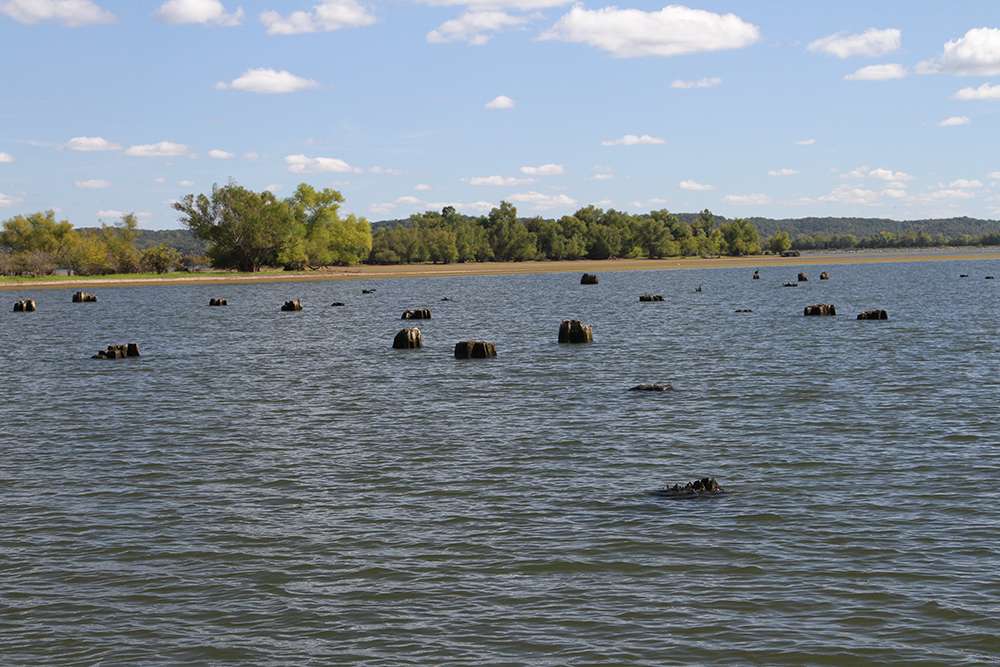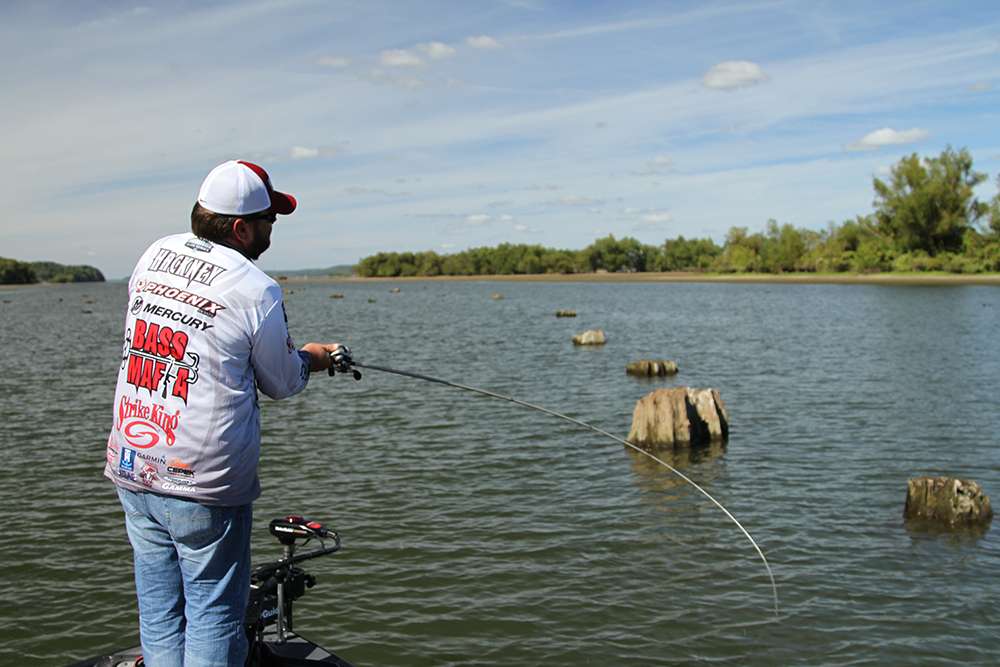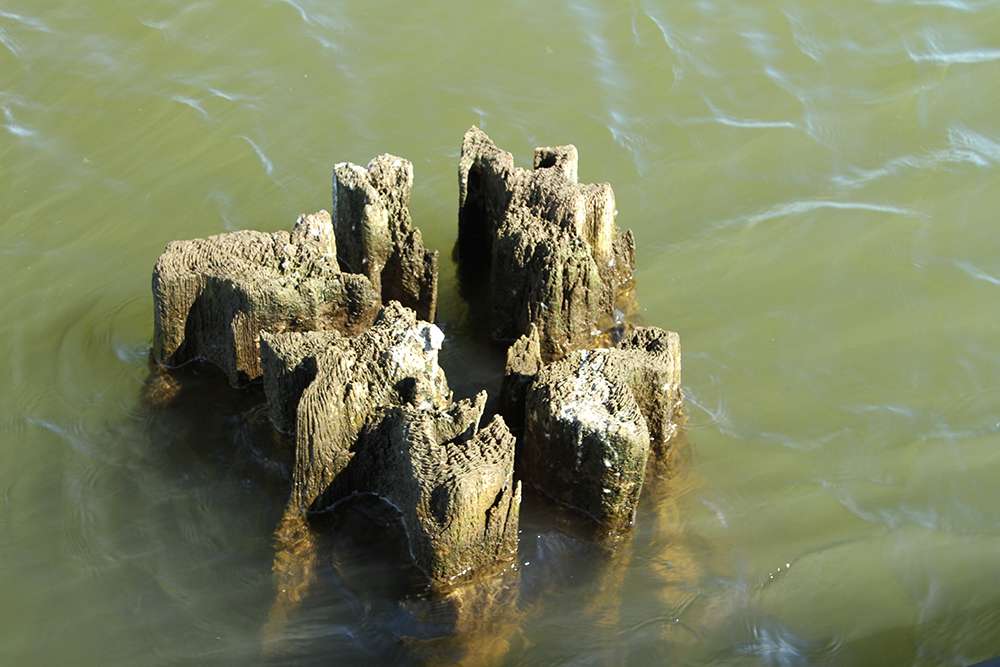
Tree falls or meets the axe and what was once a tower of wood and leaves now stands as a subtle monument to a past life. But, enough with the poetic stuff; stumps are straight-up angling assets, about which pro Greg Hackney recently shared some insightful tips.
A relevant structure in various capacities year-round, stumps prove particularly strategic to Hackney’s game plan during the fall feed-up because they help manage the playing field.
“In the fall, fish migrate to flats where they can chase bait in shallow water,” he said. “Here, stumps are a bigger deal to fisherman than to fish because this time of year, a fish doesn’t have to have cover. They relate more to bait than they do cover, like they did in the summertime.
“But they help fishermen on those days when you have high, bright skies because they give you something to throw at. The fishing can be tougher on these days and the stump gives you something to deflect a bait off of for a reaction bite; or something to pitch to on days when you don’t have wind.”
As Hackney points out, the stumps’ fall popularity is kind of an incidental deal. The fish move to the flats for the bait; not the stumps. But since the stumps aren’t going anywhere, why not use them to your advantage?
“The fish relate more around the cover than they do to the cover; they’re not as ambush-oriented as they are other times of the year,” Hackney said. “You might catch three or four bass around one stump in the fall, but maybe only one came right off the stump.”
Location, location, location
And forget running stump patterns in the fall. While warmer months often find consistencies in size or form, fall’s more about where the stump is located.
“There’ll be a 100-yard stretch that’s the sweet spot and typically that’s more about what the bait is doing,” Hackney said. “There’s something that the shad want to migrate to. Or, in areas like the Atchafalaya Basin, it’s 50 percent about the shad and 50 percent about the crawfish that start coming back out of the ground when the weather cools down. They like to come out around those stumps because they have to be cover-oriented or they’ll get picked off.”
Another fall point: Don’t get locked into that creek channel or ditch mentality we follow for summer stumpin’. This time of year, you want to identify the depth zone the bait prefers, relevant to sunlight, wind and water temperature.
“You don’t necessarily need to look for a break to catch fish on stumps in the fall, but it’s always a good idea to find out where the break is, because severe cold fronts will push fish into deeper water,” he said. “So, when you’re catching those fish in a foot or two of water on a stump flat, it’s always a good idea to think about where they’re going when falling water temperature pushes them off.”
Keepin’ it real
To frame his fall stump bait preferences, Hackney makes this observation: “Whenever you’re working a piece of cover, you can make a bait act more realistic. A fish that’s roaming open water can be a harder fish to trick than one that’s around a piece of cover. As long as he’s around that piece of cover, I can surprise him with my lure.
“In the open, he has the opportunity to see my lure way before it gets to him and he’s able to assess it. So, even though he’s not necessarily right against that stump, if he’s around it, running my bait by the stump gives the appearance of a baitfish disappearing and showing up.”
And get this: It’s a post-frontal day, that falling barometer free-for-all has fizzled and all you got is the bluebird nightmare. If the only fish he had were solely on bait, Hackney will spend the day in a deer stand. However, if he had fish on stumps, he’ll shrug off the high-pressure headache and make a run at ‘em.
“It’s not that the fish around stumps will bite any better; I can surprise the fish around stumps, I can fish different lures, I can get more out of my tackle around the cover than I can in open water,” Hackney said. “On a perfect day, it doesn’t matter. But on those (calm, clear) days, I’m going to be looking for those stumps.”

His top players
For shad looks, Hackney likes a Strike King KVD 1.5 squarebill, a Redeye Shad (lipless), a Caffeine Shad, a Hack Attack Select Spinnerbait and a Hack Attack Select Buzzbait. Notably, while the latter’s typically better early and late during the summer, he’ll sputter that big-fish getter all day long. (Tip: adding a Rage Toad or a 4-inch Caffeine Shad trailer is pure fall bliss.)
If he’s imitating stump-hugging crawfish, Hackney wants a Texas-rigged Strike King Flipping Tube or Rodent.
Mopping up
Having spent plenty of time around fall stumps, Elite pro Casey Ashley keeps a mop jig handy. Especially attractive in winter’s latter half, this enticing presentation pushes the right buttons for hungry bass.
“I like the mop jig when the water dips below 55 degrees,” Ashley said. “The fish are starting to get into that prespawn mode, they’re starting to feed up and a big profile jig in cold water gives them the kind of meal they’re looking for.
“The fish start getting into that prespawn mode (in the South) where they’re starting to feed up. That big profile, whether you like a 3/8- or a 1/2-ounce, will make that jig fall just a little slower. And when you throw it up against a stump and it hits the bottom, it flares. That big profile is going to get you the bigger bite.”
Ashley said he goes straight brown on his mop jig and adds a green pumpkin Zoom Super Chunk trailer for an authentic crawfish look befitting the winter season.
“You’re moving it just enough to make the skirt flare, but not really enough to move the bait — I call it ‘slack line hopping’,” Ashley said. “You have to move it a little, but if you can make that skirt flare and keep the bait in one spot, that’s what you’re trying to do.”






